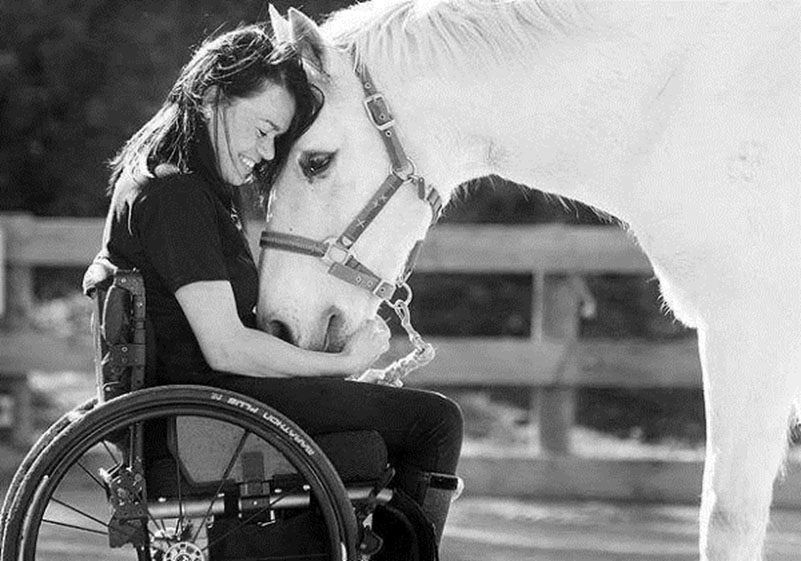Riding is not only for able-bodied people. The numerous teams taking part in the Paralympic Games and all those who, out of passion, continue to ride despite their disability, are proof of this. Besides sport and leisure riding, there is also therapy. The term rehabilitation through riding (R.P.E.) encompasses all therapeutic, re-educational and leisure measures using the beneficial effect of riding and aiming to ensure a pedagogical influence on people with physical, mental, or social disabilities.

The first equestrian centers for disabled people
The origin of rehabilitation with horses can be found in the story of Lise Hartel, a Danish dressage champion. In 1943, she was diagnosed with poliomyelitis and could only move around in a wheelchair. She decided to get back on a horse with the help of Elizabeth Bodiker, her physiotherapist and friend.
After nine years of rehabilitation, she walked with English canes and won a silver medal at the Helsinki Olympic Games… Afterwards, Ms. Bodiker decided to have young, handicapped people from her clinic ride horses.
In France, the first uses of horses in rehabilitation were studied in 1962 with people suffering from heavy physical, sensory, and mental handicaps. In 1970, the National Association for Rehabilitation through Horseback Riding was created, which later became the National Federation Handi-Cheval. It oversees developing equestrian activities for therapeutic, rehabilitative, professional but also sport and leisure purposes for disabled people or people with adaptation difficulties. Any equestrian activity, if it is adapted to the rider, can be practiced in an equestrian center: driving, acrobatics, games, horseback riding…
Several types of care for disabled people on horseback
In functional rehabilitation, we use the horse’s movement, an important source of physical dynamization. It brings into play postural reflexes and mobilizes muscle groups that are rarely used elsewhere.
In psychomotor re-education, the rhythmic and cadenced swaying, the relaxing warmth, the privileged relationship with the horse are all facilitators and reinforcers in the re-education of sensory deficits, of the body schema and of the language through the work of balance, laterality, space, and time without forgetting the relational component.
At the mental level, it turns out that “The horse is a powerful revealer of psychic phenomena, those being actualized from the bodily and imaginary experience of the one who rides it. (M. Jollinier, 1995, Cheval, inadaptations et handicaps – Maloine, Paris).
The horse is a mediator of communication. Through his behavior, he can retransmit the emotions he perceives in the rider, ease tensions by the sway of his step, the warmth of his body. The horse plays a key role with people handicapped by mental illness but also by psychosocial difficulties.
Horse equipment adapted for people with disabilities
It is sometimes more a question of adapting existing equipment than of specifically adapted equipment, which can be better accepted by people with difficulties. This equipment ranges from a wheelbarrow with two wheels that can be moved from the front, to reins with handles, balls or bridges, safety stirrups, an over-saddle with removable cleats and pads, a rubber mouthpiece… This list is not exhaustive and is completed by “D systems” that we create according to the needs.
Riding for physically disabled riders is becoming more popular. Each handicapped person has his own physical and psychological particularity, so it is difficult to compare or generalize on this vast subject! However, the physical training or physiotherapy that it implies teaches us all the benefits that come from it, without neglecting the importance of the relational and emotional impact that it induces. Having become a Paralympic discipline in Atlanta in 1996, and present in Sydney in 2000, sport horseback riding is entering the third millennium at the national and international levels. It is particularly interesting to observe the way in which the high level riders compensate for their handicap: an obvious rigor doubled with an extraordinary tact allows them to evolve as valid riders. Practicing a “legless” riding, the mental and physical objective of the gestures, its acquisition and its exploitation supported by respiratory techniques, allow me on consequent weaknesses, the construction of a muscular endurance and a functional self-control of the spinal biomechanics. This is obviously at the cost of a real effort.
It is the ultimate verification – by the handicap – of the efficiency of the “beautiful position”, gestural concept of our old masters.
A certain number of physical deficiencies can be compensated for, beyond the specific adaptations of the saddlery, thanks to an observation of the various equestrian balances and a good knowledge of the locomotion of the horse. There is therefore no special horsemanship for the disabled but only one horsemanship, the one that is written with a big E.


